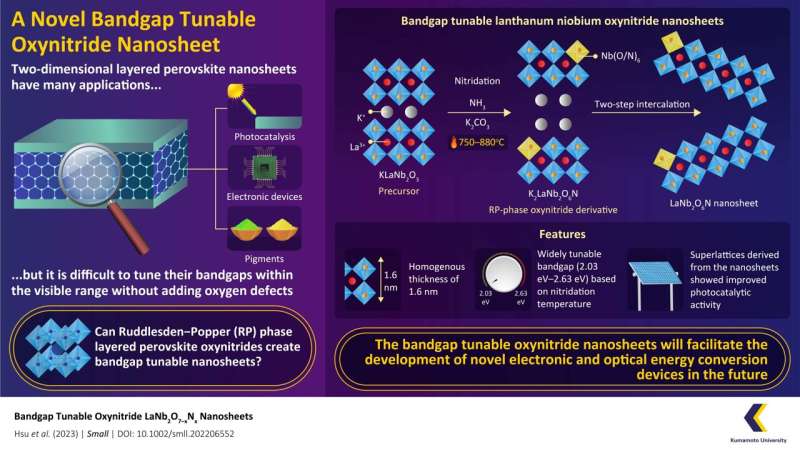Credit: Kumamoto University
Two-dimensional monolayer nanosheets made from layered perovskite have many desirable properties. However, it has been difficult to create them with tunable bandgaps in the visible region without adding oxygen defects. Recently, researchers from Japan were able to successfully develop chemically stable nanosheets from perovskite oxynitrides which had controllable bandgaps. These nanosheets have immense potential for future use in photocatalysis, electrocatalysts, and other sustainable technologies.
Nanosheets, which include the well-known material graphene, are materials that possess nanoscale homogenous thicknesses, flat surfaces, and high crystallinity. Nanosheets have wide applications in photocatalysis, photoluminescence, and electronics.
Recently, perovskites, which have semiconductor properties, have received attention in the scientific community as a promising material for producing two-dimensional (2D) monolayer nanosheets. However, these nanosheets would need have a bandgap corresponding to the energy of visible light to be useful, as this would determine when the semiconductor conducts electricity. The tunability of the bandgap has remained a major challenge for researchers, as creating 2D nanosheets from perovskite with a tunable bandgap is difficult.
To solve this problem, a team of researchers from Kumamoto University, including Professor Shintaro Ida from the Institute of Industrial Nanomaterials, decided to focus on a group of perovskite materials known as Ruddlesden–Popper (RP) phase layered perovskite oxynitrides. In their paper published in the journal Small, the researchers were able to successfully create 2D perovskite oxynitride nanosheets with a tunable bandgap using their novel process.
"Metal oxynitride semiconductor nanosheets containing oxygen, nitrogen, and a metal have not been researched much. Thin films made of these materials demonstrate functions superior to those of oxides. Thus, their synthesis will have a huge impact in this field. We synthesized nanosheets from RP-phase perovskite oxynitrides whose properties, such as its bandgap, are freely tunable," explains Prof. Ida, who is the corresponding author of the study.
The researchers first used pristine Dion–Jacobson phase lanthanum niobium oxide (KLaNb2O7) as a precursor material. They then proceeded to add nitrogen to this via a process called nitridation. The researchers added nitrogen at different temperatures ranging from 750 to 800℃ to the material. This led to the creation of the RP-phase oxynitride derivative. Following this, they were able to use a two-step intercalation process to exfoliate out lanthanum niobium oxynitride nanosheets with the formula LaNb2O7-xNx ('x' being the amount of nitrogen added to the perovskite).
On testing these nanosheets, the researchers saw that the material had a homogenous thickness of 1.6 nm and exhibited different colors, ranging from white to yellow, depending on the nitridation temperature. The nanosheets also exhibited the desirable semiconductor property of having a tunable bandgap in the visible region, ranging from 2.03–2.63 eV, based on the nitridation temperature.
The team then prepared a "superlattice" structure consisting of alternating layers of the synthesized nanosheets and oxide (Ca2Nb3O10) nanosheets. On testing the properties of this superlattice, they found that it exhibited superior proton conductivity and excellent photocatalytic activity.
"The results of this study will open new possibilities for producing multiple superlattices by employing soft−chemical nano−architectonics based on 2D nanosheets," says Prof. Ida. "This will get us one step closer to a sustainable society, as these nanosheets would enable efficient splitting of water as a photocatalyst and also in creating more complex and better performing electronics."
More information: Chu‐Wei Hsu et al, Bandgap Tunable Oxynitride LaNb 2 O 7–x N x Nanosheets, Small (2023). DOI: 10.1002/smll.202206552
Journal information: Small
Provided by Kumamoto University























